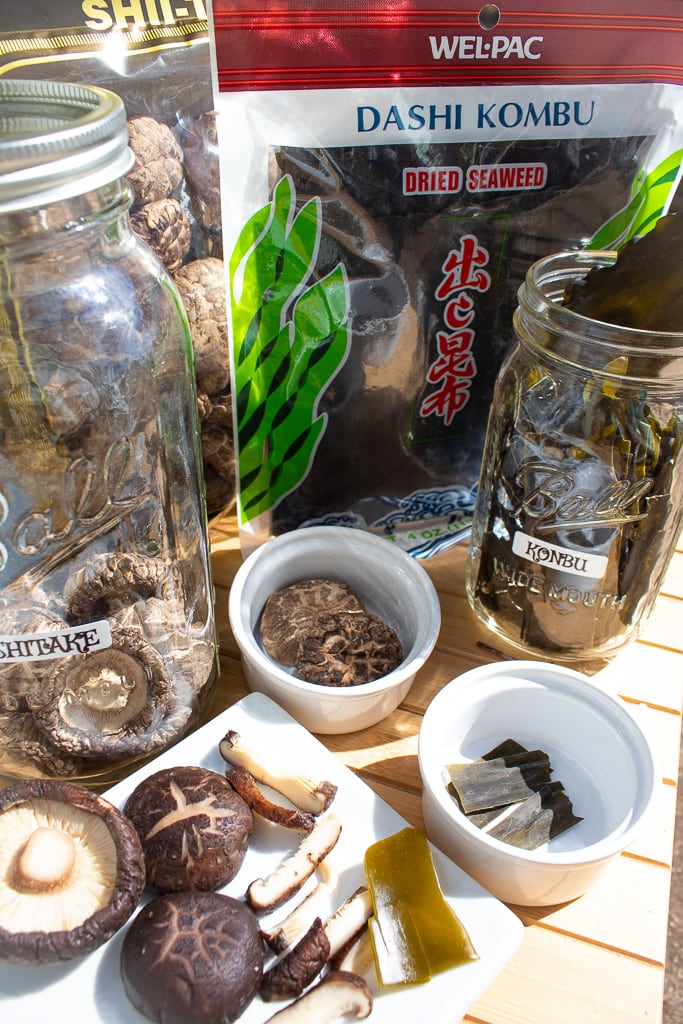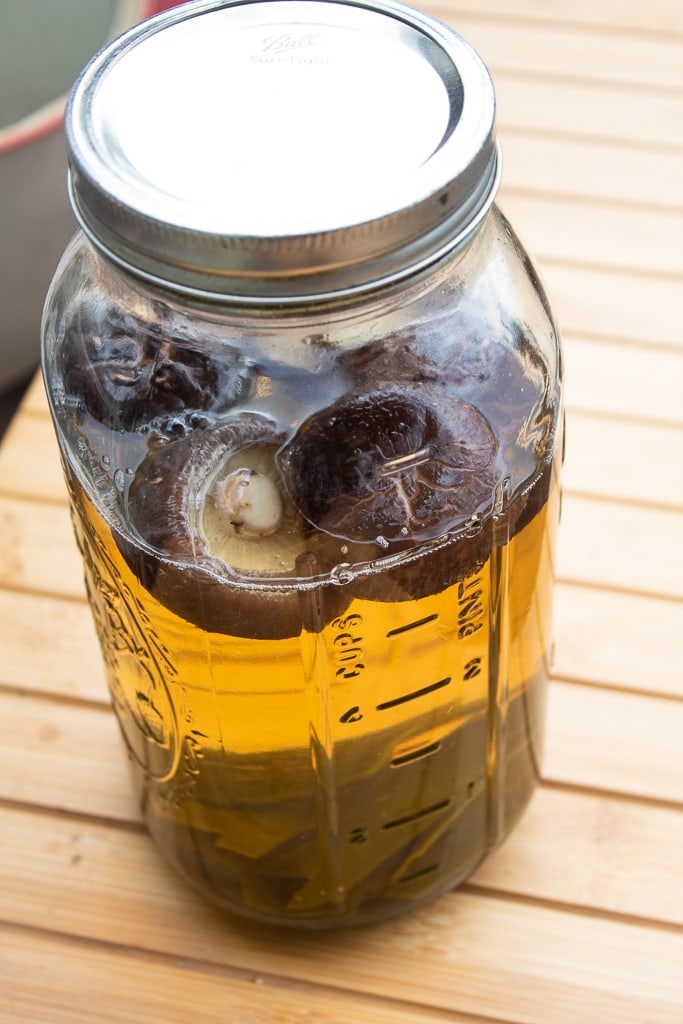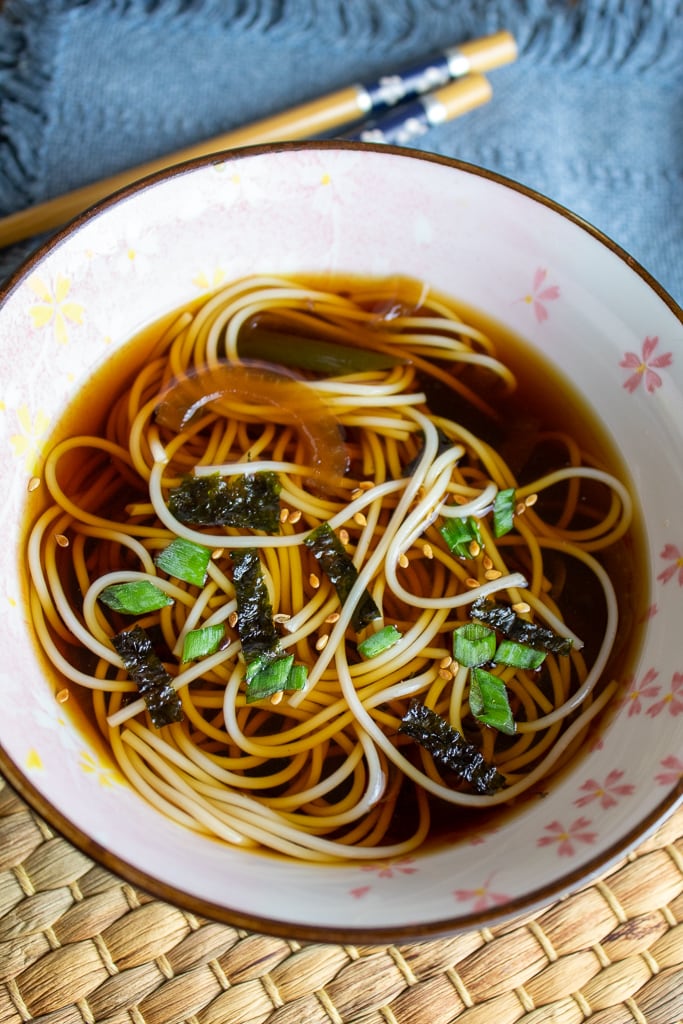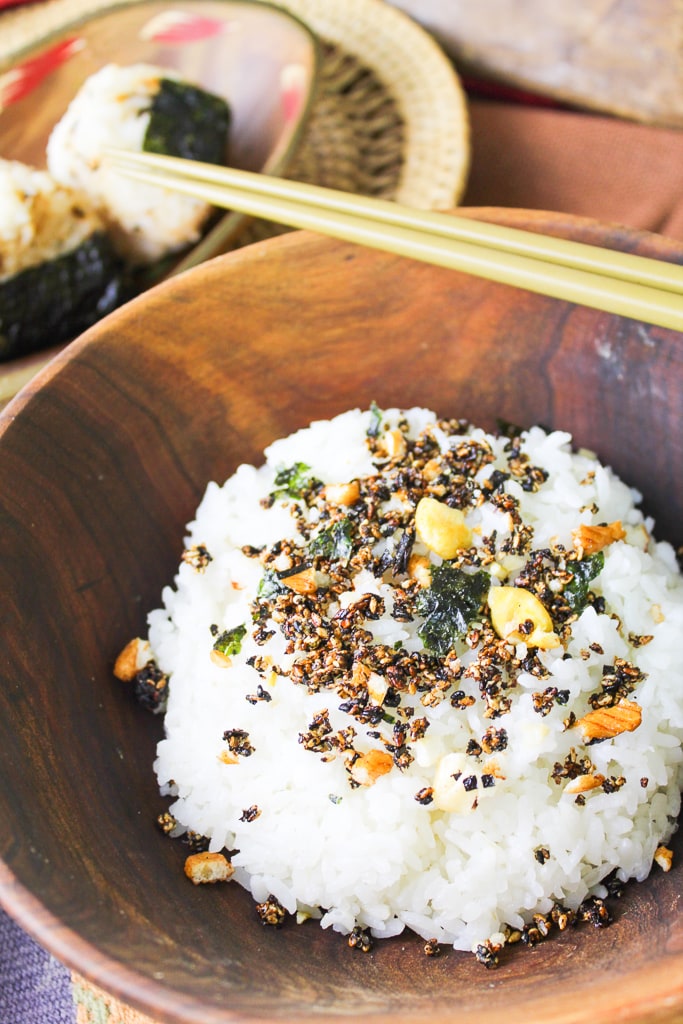Easy Dashi Stock (Japanese Soup Broth)
Dashi Stock is the key ingredient in many Japanese recipes, soups, and sauces. Using only 2 ingredients plus water, this meatless broth adds a deep, rich flavor to Asian and American dishes alike. It’s so simple, anyone can make it!

Dashi broth is super easy to make using only 2 ingredients, plus water, and a jar. It’s also wonderful to keep on hand to use for a quick ramen noodle bowl and can be used as a substitute for your usual vegetable broth even in American dishes.
This simple kombu dashi recipe is from Drenda-Michell Brennan who is an amazing Japanese cook and also happens to be my sister. She lived in Japan back in the 1980s and early 90s and has a wealth of information as you will see from this recipe and others like Easy Veggie Sushi and How to Make Sushi Rice.
Article by: Drenda-Michell Brennan
What is Japanese dashi stock?
Dashi is a soup base and a fundamental ingredient in many Japanese dishes and sauces. Dashi stock embodies the ‘umami’ or fifth taste, a strong savory flavor often associated with Asian cuisine. You might even want to try this Easy Umami Sauce recipe if you really like the flavor.
Ingredients in dashi broth

- Kombu (called kombu or konbu)- Kombu is used to make dashi because it provides a rich umami flavor that forms the base of the broth. Its natural glutamates enhance the depth and savoriness of the dashi, making it an essential ingredient for creating a well-rounded, flavorful stock in Japanese cuisine.
- Shitake mushrooms- Creates a complex flavor perfect for a soup base for vegetarian, vegan, and plant-based diets.
What is kombu?
Kombu (or konbu, as it is known in Asia) is a seaweed grown mainly in Japan. When harvested, the sea vegetable’s long leaves are dried into brittle-edible sheets perfect for producing a savory soup stock. A kombu-infused soup base creates a rich umami flavor that is packed with nutrients. You can find kombu in Asian markets and even online.
Shitake mushrooms
Shitake mushrooms are also of Japanese origin. They have become extremely popular in the United States over the last couple of decades and with good reason, the flavor alone makes them a staple item! They also have a number of nutritional and medicinal values associated with them.
Shitake mushrooms are generally sold dehydrated, so they are easy to store, and they are available in many grocery stores, as well as in Asian markets, and online.
How to make dashi stock
The recipe card at the bottom of the page has the full list of ingredients with measurements and instructions.
This is the easiest vegetable broth you will ever make. The measurements don’t have to be precise, they are just guidelines to help you get started. Several different methods can be used as you will see below.
I generally multiply the measurements by four, to make 4 cups of dashi broth at a time so that I always have it on hand. This is enough for two generous adult-size noodle bowls if you are using it for a soup base.

STEP #1: My preferred method is a cold brew for full-flavor intensity and simplicity. I use a half-gallon canning jar, but any container large enough to hold the amount of dashi you are making will work.
Add the ingredients, shake or stir, and allow to sit for 8 hours at room temperature or overnight

STEP #2: By morning it’s done. Remove the kombu and mushrooms from the dashi and refrigerate the stock until you are ready to use it.
See my suggestions for repurposing the kombu and mushrooms below.
Quick Method
Another method you can use in a time pinch is soaking the kombu and shitake in water for 2-3 hours. The flavor will be enhanced if you can start out with hot water. Maximize the soak time, longer is better to develop the flavor.
Intense Flavor Method
To release more flavor, you can also heat the dashi mixture slowly on the stovetop. Bring to a simmer, but do not allow it to boil.
Ways to use dashi broth
A great way to use it would be in this 20-Minute Miso Soup Recipe. Also, keep it on hand to use in a quick miso ramen noodle bowl, and it can be used as a substitute for your usual vegetable broth even in American dishes.
We make a lot of vegan stir fry recipes at my house and, since I don’t cook with any oil, veggie broth like this one is a great way to stir fry without using any oil.
Pro tips & suggestions
Repurpose- An additional perk is that once you’re done making your dashi broth you can re-purpose the spent kombu and shitake.
- The shitake mushrooms are ready to eat! Simply remove the stems, they are too tough to eat, and chop or slice the mushroom heads up to throw into your soups and stir-fries.
- The kombu can be re-purposed to use in making furikake, a simple rice seasoning you can sprinkle on rice and other dishes (recipe coming soon).
- The spent kombu and shitake can be stored in covered containers in the fridge for up to a week or freeze them if you plan to wait and use them later on.
Frequently Asked Questions
You can use bonito flakes alone to make dashi, but it will not be vegan since bonito flakes are made from tuna. The flavor will be lighter and less complex than the traditional combination of kombu and mushrooms.
To store kombu dashi, keep it covered and refrigerated until you are ready to use it. It will save up to 14 days in the fridge. It can be frozen in a freezer-safe bag or container for at least 3 months.

For those of you new to the whole food plant-based lifestyle, we’ve created a FREE 7-Day Plant-Based Menu Planner to help you get started!
If you try this recipe, please let us know how you like it by rating it and leaving a comment. We love to hear from you!
Want to Save This Recipe?
Enter your email & I’ll send it to your inbox. Plus, get great new recipes from me every week!
By submitting this form, you consent to receive emails from EatPlant-Based

Dashi Stock (Japanese Soup Broth)
Ingredients
- 1 cup water for single serving
- 1 dried shitake mushroom
- 2 square kombu seaweej about 15 grams
Instructions
- This is the easiest vegetable broth you will ever make. The measurements don’t have to be precise, they are just guidelines to help you get started. There are a number of different methods that can be used as you will below.
- I generally multiply the measurements by four, to make 4 cups of dashi broth at a time so that I always have it on hand. This is enough for two generous adult-size noodle bowls if you are using it for a soup base.
Preparation methods
- Cold brew- My preferred method is a cold brew for full-flavor intensity and simplicity. I use a half-gallon canning jar, but any container large enough to hold the amount of dashi you are making will work. Add the ingredients, shake or stir, and allow to sit at room temperature for 8 hours or overnight. By morning it’s done. Remove the kombu and mushrooms from the dashi and refrigerate the stock until you are ready to use it.
- Quick version-Another method you can use in a time pinch is soaking the kombu and shitake in water for 2-3 hours. The flavor will be enhanced if you can start out with hot water. Maximize the soak time, longer is better to develop the flavor.
- Intense flavor method- To release more flavor, you can also heat the dashi mixture slowly on the stovetop. Bring to a simmer, but do not allow it to boil.
Video
Notes
- The shitake mushrooms are ready to eat! Simply remove the stems, they are too tough to eat, and chop or slice the mushroom heads up to throw into your soups and stir-fries.
- The kombu can be re-purposed to use in making furikake, a simple rice seasoning you can sprinkle on rice and other dishes (recipe coming soon).
- The spent kombu and shitake can be stored in covered containers in the fridge for up to a week or freeze them if you plan to wait and use them later on.
Nutrition
Disclaimer
To obtain the most accurate representation of the nutritional information in a given recipe, you should calculate the nutritional information with the actual ingredients used in your recipe, using your preferred nutrition calculator. You are solely responsible for ensuring that any nutritional information provided is accurate, complete, and useful.
About the Chef
Drenda-Michell Brennan lived in Japan in the 1980s and 90s where she enjoyed spending much of her time visiting the kitchens of family and friends, watching and learning to prepare traditional Japanese cuisine. She is the mother of three Japanese-American grown children and grandmother (HuneyGram) to nine grandchildren. Read More…






Due to timing, I may need to leave it for closer to 10 hours than 8; is that an ok thing to do or should I wait til I can strain and refrigerate after 8?
ACC- Leaving it for more than 8 hours is just fine. Oftentimes, we leave it overnight.